tow CHEVROLET COBALT 2007 1.G Owner's Guide
[x] Cancel search | Manufacturer: CHEVROLET, Model Year: 2007, Model line: COBALT, Model: CHEVROLET COBALT 2007 1.GPages: 450, PDF Size: 2.48 MB
Page 270 of 450
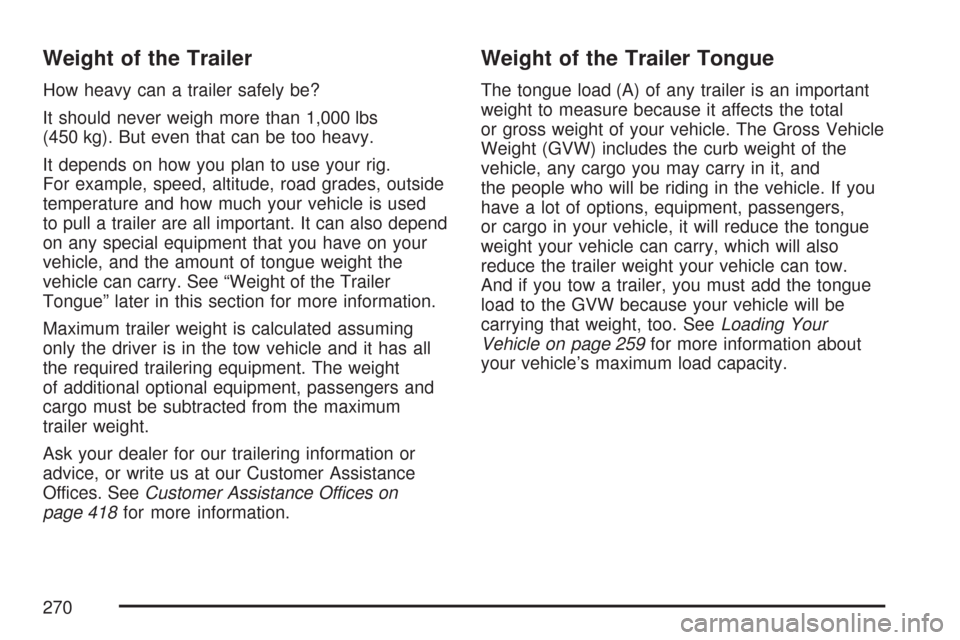
Weight of the Trailer
How heavy can a trailer safely be?
It should never weigh more than 1,000 lbs
(450 kg). But even that can be too heavy.
It depends on how you plan to use your rig.
For example, speed, altitude, road grades, outside
temperature and how much your vehicle is used
to pull a trailer are all important. It can also depend
on any special equipment that you have on your
vehicle, and the amount of tongue weight the
vehicle can carry. See “Weight of the Trailer
Tongue” later in this section for more information.
Maximum trailer weight is calculated assuming
only the driver is in the tow vehicle and it has all
the required trailering equipment. The weight
of additional optional equipment, passengers and
cargo must be subtracted from the maximum
trailer weight.
Ask your dealer for our trailering information or
advice, or write us at our Customer Assistance
Offices. SeeCustomer Assistance Offices on
page 418for more information.
Weight of the Trailer Tongue
The tongue load (A) of any trailer is an important
weight to measure because it affects the total
or gross weight of your vehicle. The Gross Vehicle
Weight (GVW) includes the curb weight of the
vehicle, any cargo you may carry in it, and
the people who will be riding in the vehicle. If you
have a lot of options, equipment, passengers,
or cargo in your vehicle, it will reduce the tongue
weight your vehicle can carry, which will also
reduce the trailer weight your vehicle can tow.
And if you tow a trailer, you must add the tongue
load to the GVW because your vehicle will be
carrying that weight, too. SeeLoading Your
Vehicle on page 259for more information about
your vehicle’s maximum load capacity.
270
Page 272 of 450
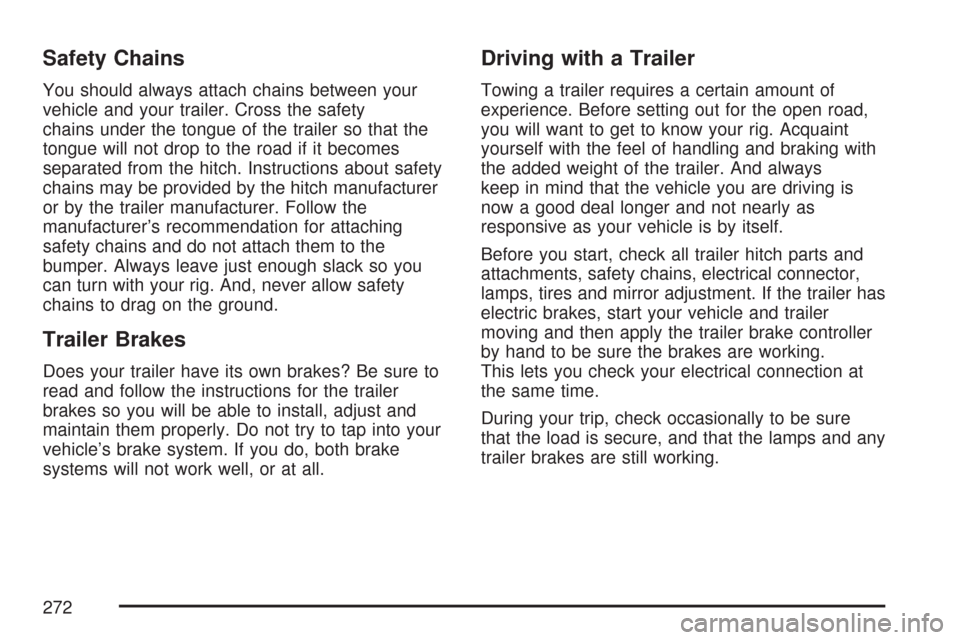
Safety Chains
You should always attach chains between your
vehicle and your trailer. Cross the safety
chains under the tongue of the trailer so that the
tongue will not drop to the road if it becomes
separated from the hitch. Instructions about safety
chains may be provided by the hitch manufacturer
or by the trailer manufacturer. Follow the
manufacturer’s recommendation for attaching
safety chains and do not attach them to the
bumper. Always leave just enough slack so you
can turn with your rig. And, never allow safety
chains to drag on the ground.
Trailer Brakes
Does your trailer have its own brakes? Be sure to
read and follow the instructions for the trailer
brakes so you will be able to install, adjust and
maintain them properly. Do not try to tap into your
vehicle’s brake system. If you do, both brake
systems will not work well, or at all.
Driving with a Trailer
Towing a trailer requires a certain amount of
experience. Before setting out for the open road,
you will want to get to know your rig. Acquaint
yourself with the feel of handling and braking with
the added weight of the trailer. And always
keep in mind that the vehicle you are driving is
now a good deal longer and not nearly as
responsive as your vehicle is by itself.
Before you start, check all trailer hitch parts and
attachments, safety chains, electrical connector,
lamps, tires and mirror adjustment. If the trailer has
electric brakes, start your vehicle and trailer
moving and then apply the trailer brake controller
by hand to be sure the brakes are working.
This lets you check your electrical connection at
the same time.
During your trip, check occasionally to be sure
that the load is secure, and that the lamps and any
trailer brakes are still working.
272
Page 273 of 450
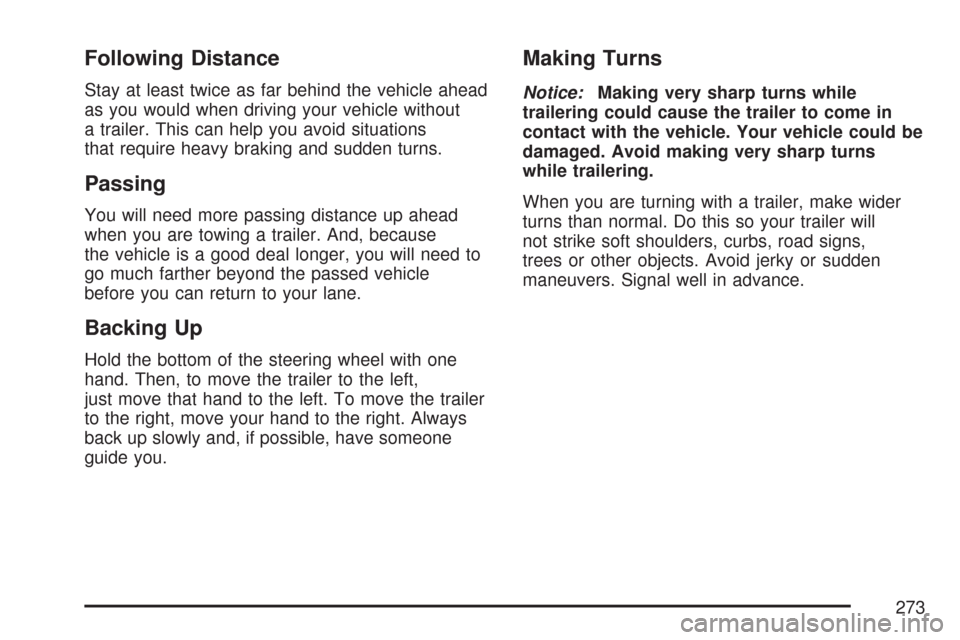
Following Distance
Stay at least twice as far behind the vehicle ahead
as you would when driving your vehicle without
a trailer. This can help you avoid situations
that require heavy braking and sudden turns.
Passing
You will need more passing distance up ahead
when you are towing a trailer. And, because
the vehicle is a good deal longer, you will need to
go much farther beyond the passed vehicle
before you can return to your lane.
Backing Up
Hold the bottom of the steering wheel with one
hand. Then, to move the trailer to the left,
just move that hand to the left. To move the trailer
to the right, move your hand to the right. Always
back up slowly and, if possible, have someone
guide you.
Making Turns
Notice:Making very sharp turns while
trailering could cause the trailer to come in
contact with the vehicle. Your vehicle could be
damaged. Avoid making very sharp turns
while trailering.
When you are turning with a trailer, make wider
turns than normal. Do this so your trailer will
not strike soft shoulders, curbs, road signs,
trees or other objects. Avoid jerky or sudden
maneuvers. Signal well in advance.
273
Page 274 of 450
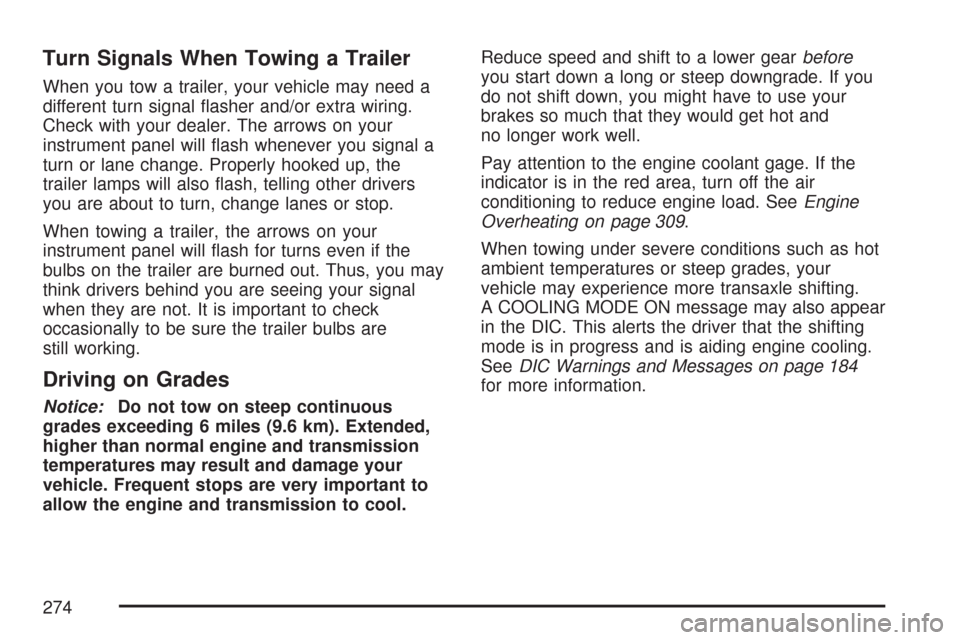
Turn Signals When Towing a Trailer
When you tow a trailer, your vehicle may need a
different turn signal �asher and/or extra wiring.
Check with your dealer. The arrows on your
instrument panel will �ash whenever you signal a
turn or lane change. Properly hooked up, the
trailer lamps will also �ash, telling other drivers
you are about to turn, change lanes or stop.
When towing a trailer, the arrows on your
instrument panel will �ash for turns even if the
bulbs on the trailer are burned out. Thus, you may
think drivers behind you are seeing your signal
when they are not. It is important to check
occasionally to be sure the trailer bulbs are
still working.
Driving on Grades
Notice:Do not tow on steep continuous
grades exceeding 6 miles (9.6 km). Extended,
higher than normal engine and transmission
temperatures may result and damage your
vehicle. Frequent stops are very important to
allow the engine and transmission to cool.Reduce speed and shift to a lower gearbefore
you start down a long or steep downgrade. If you
do not shift down, you might have to use your
brakes so much that they would get hot and
no longer work well.
Pay attention to the engine coolant gage. If the
indicator is in the red area, turn off the air
conditioning to reduce engine load. SeeEngine
Overheating on page 309.
When towing under severe conditions such as hot
ambient temperatures or steep grades, your
vehicle may experience more transaxle shifting.
A COOLING MODE ON message may also appear
in the DIC. This alerts the driver that the shifting
mode is in progress and is aiding engine cooling.
SeeDIC Warnings and Messages on page 184
for more information.
274
Page 276 of 450
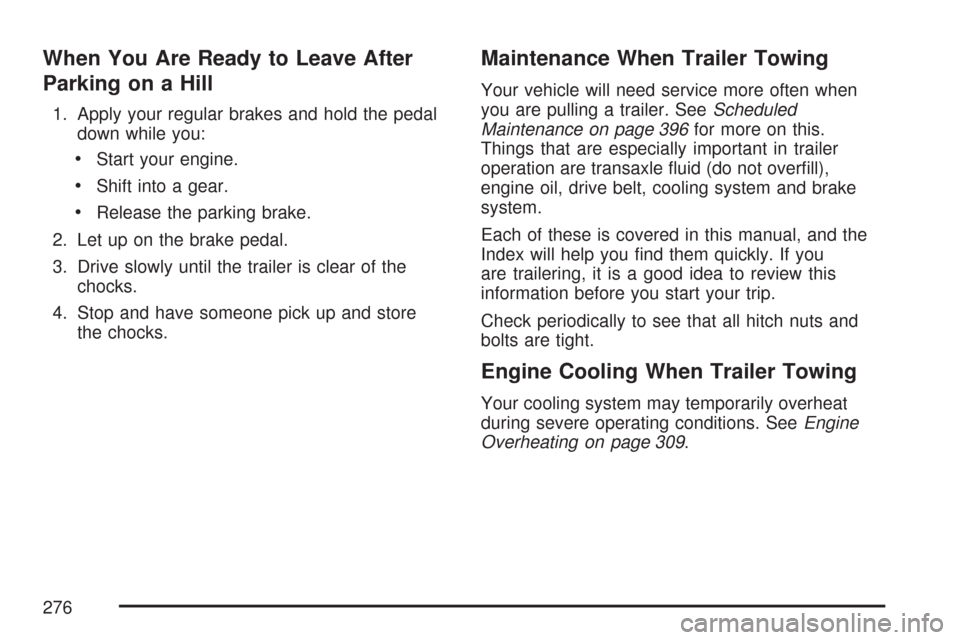
When You Are Ready to Leave After
Parking on a Hill
1. Apply your regular brakes and hold the pedal
down while you:
Start your engine.
Shift into a gear.
Release the parking brake.
2. Let up on the brake pedal.
3. Drive slowly until the trailer is clear of the
chocks.
4. Stop and have someone pick up and store
the chocks.
Maintenance When Trailer Towing
Your vehicle will need service more often when
you are pulling a trailer. SeeScheduled
Maintenance on page 396for more on this.
Things that are especially important in trailer
operation are transaxle �uid (do not over�ll),
engine oil, drive belt, cooling system and brake
system.
Each of these is covered in this manual, and the
Index will help you �nd them quickly. If you
are trailering, it is a good idea to review this
information before you start your trip.
Check periodically to see that all hitch nuts and
bolts are tight.
Engine Cooling When Trailer Towing
Your cooling system may temporarily overheat
during severe operating conditions. SeeEngine
Overheating on page 309.
276
Page 289 of 450

Hood Release
To open the hood, do the following.
1. Pull the interior hood
release lever with
this symbol on it.
It is located under
the instrument panel
on the driver’s side
of the vehicle.
2. Then go to the front of the vehicle and push
the secondary hood release lever to the left.
It is located under the front center of the hood
toward the driver’s side of the vehicle.
3. After you have partially lifted the hood, a gas
strut will automatically take over to lift and
hold the hood in the fully open position.
Before closing the hood, be sure all the �ller
caps are on properly. Lower the hood until
the lifting force of the strut is reduced,
then release the hood to latch fully. Check
to make sure the hood is closed and repeat
the process if necessary.
289
Page 293 of 450

A. Windshield Washer Fluid Reservoir. See
“Adding Washer Fluid” underWindshield
Washer Fluid on page 317.
B. Engine Oil Dipstick. See “Checking Engine Oil”
underEngine Oil on page 293.
C. Engine Oil Fill Cap. See “When to Add Engine
Oil” underEngine Oil on page 293.
D. Intercooler System Pressure Cap. SeeEngine
Coolant on page 302.
E. Brake Master Cylinder Reservoir. See “Brake
Fluid” underBrakes on page 318andHydraulic
Clutch on page 302.
F. Engine Compartment Fuse Block. SeeEngine
Compartment Fuse Block on page 386.
G. Remote Positive (+) Terminal. SeeJump
Starting on page 322.
H. Remote Negative (−) Terminal. SeeJump
Starting on page 322.
I. Engine Coolant Surge Tank. SeeCooling
System on page 311.
J. Engine Air Cleaner/Filter. SeeEngine
Air Cleaner/Filter on page 300.Engine Oil
Checking Engine Oil
It is a good idea to check the engine oil every time
you get fuel. In order to get an accurate reading,
the oil must be warm and the vehicle must be
on level ground.
The engine oil dipstick handle is a yellow loop.
SeeEngine Compartment Overview on page 290
for the location of the engine oil dipstick.
1. Turn off the engine and give the oil several
minutes to drain back into the oil pan. If you
do not do this, the oil dipstick might not
show the actual level.
2. Pull out the dipstick and clean it with a paper
towel or cloth, then push it back in all the
way. Remove it again, keeping the tip down,
and check the level.
293
Page 310 of 450
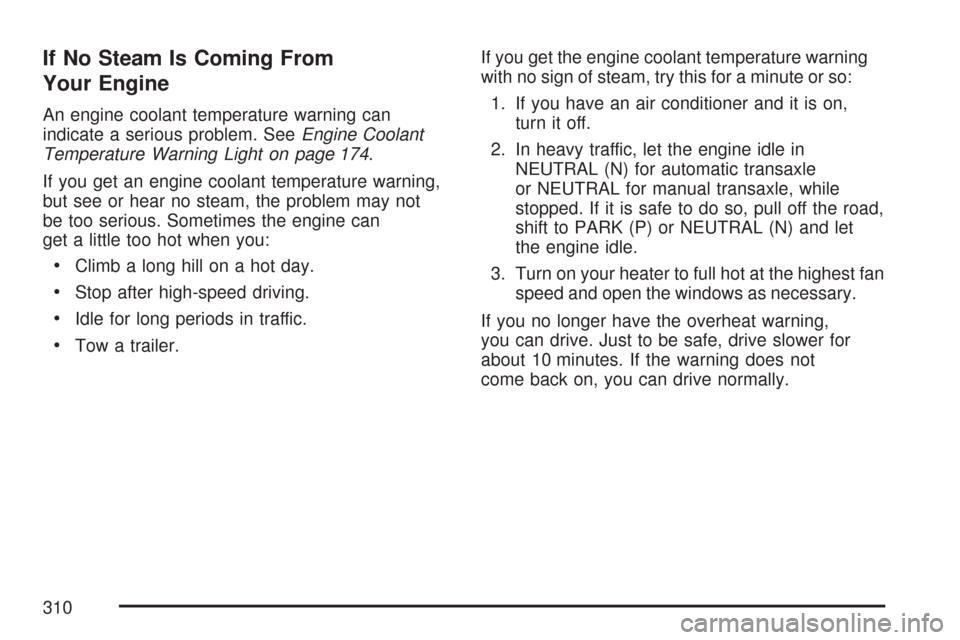
If No Steam Is Coming From
Your Engine
An engine coolant temperature warning can
indicate a serious problem. SeeEngine Coolant
Temperature Warning Light on page 174.
If you get an engine coolant temperature warning,
but see or hear no steam, the problem may not
be too serious. Sometimes the engine can
get a little too hot when you:
Climb a long hill on a hot day.
Stop after high-speed driving.
Idle for long periods in traffic.
Tow a trailer.If you get the engine coolant temperature warning
with no sign of steam, try this for a minute or so:
1. If you have an air conditioner and it is on,
turn it off.
2. In heavy traffic, let the engine idle in
NEUTRAL (N) for automatic transaxle
or NEUTRAL for manual transaxle, while
stopped. If it is safe to do so, pull off the road,
shift to PARK (P) or NEUTRAL (N) and let
the engine idle.
3. Turn on your heater to full hot at the highest fan
speed and open the windows as necessary.
If you no longer have the overheat warning,
you can drive. Just to be safe, drive slower for
about 10 minutes. If the warning does not
come back on, you can drive normally.
310
Page 332 of 450
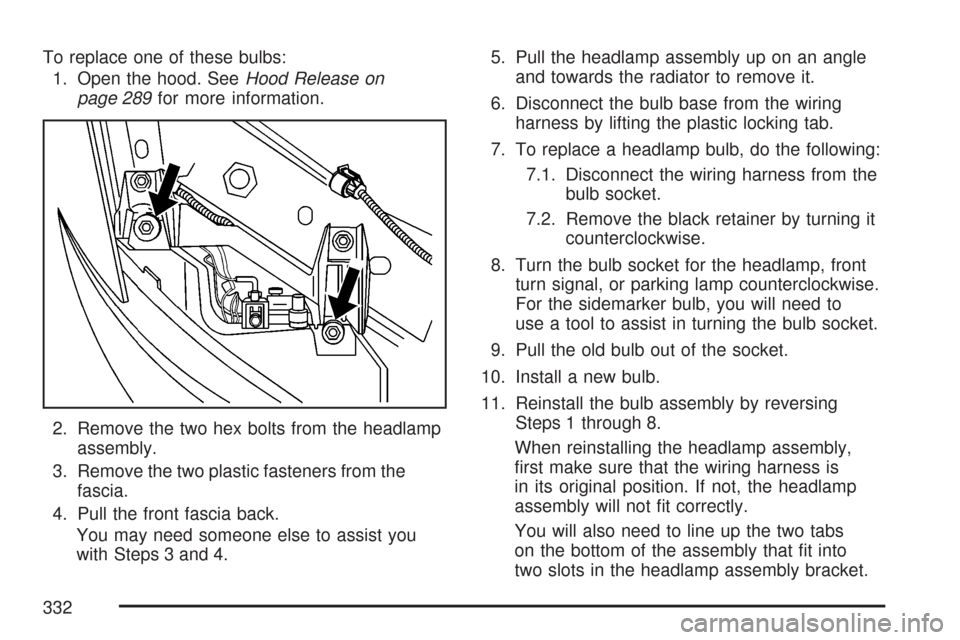
To replace one of these bulbs:
1. Open the hood. SeeHood Release on
page 289for more information.
2. Remove the two hex bolts from the headlamp
assembly.
3. Remove the two plastic fasteners from the
fascia.
4. Pull the front fascia back.
You may need someone else to assist you
with Steps 3 and 4.5. Pull the headlamp assembly up on an angle
and towards the radiator to remove it.
6. Disconnect the bulb base from the wiring
harness by lifting the plastic locking tab.
7. To replace a headlamp bulb, do the following:
7.1. Disconnect the wiring harness from the
bulb socket.
7.2. Remove the black retainer by turning it
counterclockwise.
8. Turn the bulb socket for the headlamp, front
turn signal, or parking lamp counterclockwise.
For the sidemarker bulb, you will need to
use a tool to assist in turning the bulb socket.
9. Pull the old bulb out of the socket.
10. Install a new bulb.
11. Reinstall the bulb assembly by reversing
Steps 1 through 8.
When reinstalling the headlamp assembly,
�rst make sure that the wiring harness is
in its original position. If not, the headlamp
assembly will not �t correctly.
You will also need to line up the two tabs
on the bottom of the assembly that �t into
two slots in the headlamp assembly bracket.
332
Page 336 of 450
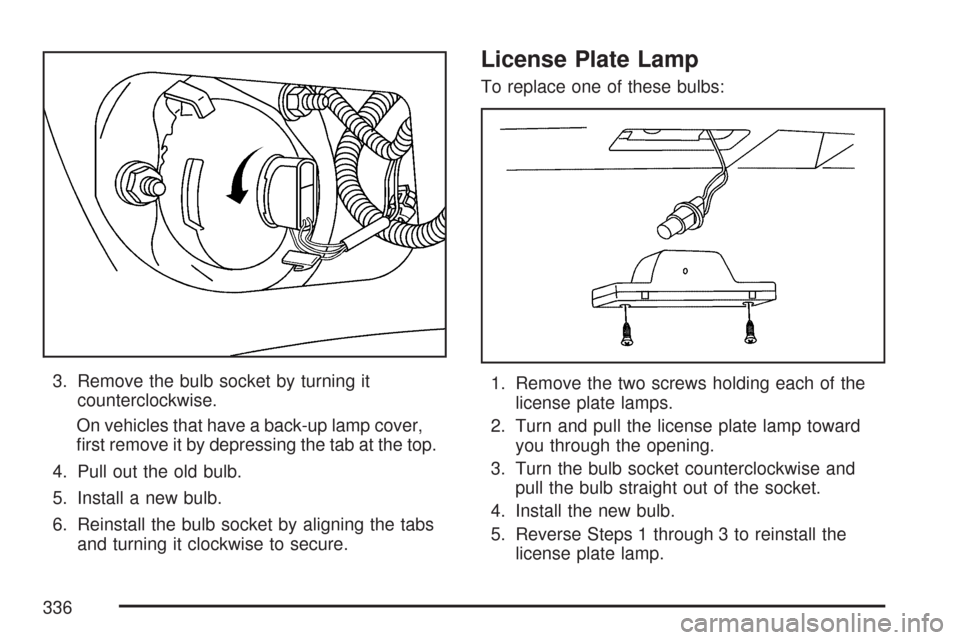
3. Remove the bulb socket by turning it
counterclockwise.
On vehicles that have a back-up lamp cover,
�rst remove it by depressing the tab at the top.
4. Pull out the old bulb.
5. Install a new bulb.
6. Reinstall the bulb socket by aligning the tabs
and turning it clockwise to secure.
License Plate Lamp
To replace one of these bulbs:
1. Remove the two screws holding each of the
license plate lamps.
2. Turn and pull the license plate lamp toward
you through the opening.
3. Turn the bulb socket counterclockwise and
pull the bulb straight out of the socket.
4. Install the new bulb.
5. Reverse Steps 1 through 3 to reinstall the
license plate lamp.
336